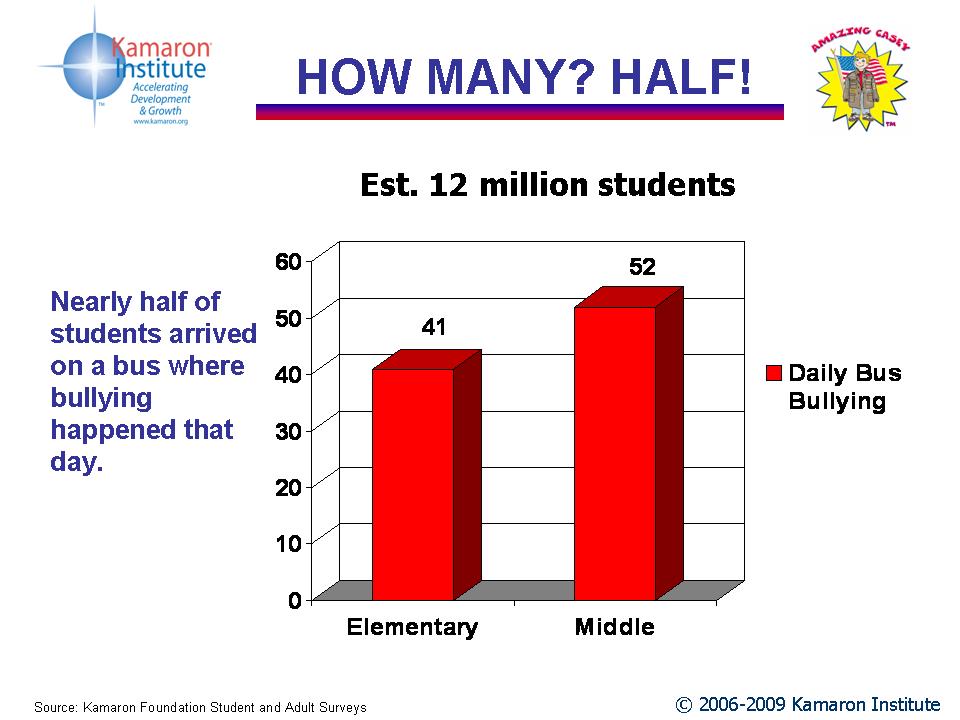Cyber-Bullying Is Technology Powered
Cyber-bullying incidents have quadrupled. Most students don’t tell their parents.
by Margaret Ross, Kamaron Institute
 Approximately half of U.S. students are impacted by traditional bullying each school day. It happens on buses, in the cafeteria, gym, hallways, playground, and in classrooms. The most frequent form bullying takes is words (teasing, taunting, ridiculing, name-calling, and gossip - not blows). This type of bullying happens in the “physical” world and that world has time and space limits. Cyber-bullying is making school days even more painful for many children and some school staff. Bullying in cyberspace is not bound by school hours, school days, or facing the intended bully victim. Unfortunately, the perceived anonymous nature of the internet often insulates the bully from the consequences of their damaging behavior.
Approximately half of U.S. students are impacted by traditional bullying each school day. It happens on buses, in the cafeteria, gym, hallways, playground, and in classrooms. The most frequent form bullying takes is words (teasing, taunting, ridiculing, name-calling, and gossip - not blows). This type of bullying happens in the “physical” world and that world has time and space limits. Cyber-bullying is making school days even more painful for many children and some school staff. Bullying in cyberspace is not bound by school hours, school days, or facing the intended bully victim. Unfortunately, the perceived anonymous nature of the internet often insulates the bully from the consequences of their damaging behavior.
As the number of households with Internet access approaches saturation and cell phone ownership expands to the 100 million mark, so do the ways kids bully each other. Cyber-bullying in the form of text messages, emails, photos, website postings can go school-wide in minutes and global in days. Slanderous information sent out into cyberspace is difficult, if not impossible, to expunge. Cyber-bullying often takes the form of cyber gossip, where damaging content is based on whim; not facts, and is posted on social networking sites such as MySpace and FaceBook.
Cyber-Bullying Getting Bigger: Studies indicate that cyber-bullying incidents have quadrupled in five years. A 2000 survey by the Crimes Against Children Research center at the University of New Hampshire reported 6 % of young people had experienced some form of cyber-bullying. In 2005, studies of 1500 Internet-using adolescents found that over one-third had been cyber bulled and half of those admitted to cyber-bullying others (Hinduja and Patchin, In Review.) A 2005 study by National Children’s Home Charity revealed that 20% had been cyber-bullying victims. A 2004 survey conducted by i-Safe America of 1556 adolescents found that 42 % had been bullied online.
How Cyber-Bulling Messages Are Communicated:
- Text or digital imaging messages sent on cell phones
- e-mails
- instant messaging
- web pages
- web logs (blogs),
- chat rooms or discussion groups, and
- other information communication technologies
Cyber-bullying Perpetrators - It Is A Cycle:
- Middle School and High School girls were about twice as likely as boys to display cyber-bullying behaviors in the form of email, text, and chat*
- Middle School and High School girls were twice as likely as boys to report receiving email, text messages or chat room messages that teased, taunted, and ridiculed. *
- 62% said that they had been cyber-bullied by another student at school, and 46% had been cyber-bullied by a friend. **
- 55% didn’t know who had cyber-bullied them.
Only 20% cyber-bullying victims tell their parents about the incident. Victims are most likely to tell a friend (42%).
**(2005, Kowalski et al., Electronic bullying among school-aged children and youth.)
* (2007-2009, Kamaron Institute, School Surveys)
Ten Tips: Parents Cyber-Bullying Preemption
- Consider installing filtering and blocking software, but understand clearly that proactive parents are the only real deterrent and the best resource for bullying preemption.
- Keep your home computer(s) in easily viewable places, such as a family room or kitchen.
- Model the behavior you want to see in your child
- Talk regularly with your child about on-line activities he or she is involved in.
- Set firm guidelines for cell phone use and monitor that behavior.
- Talk specifically about cyber-bullying. Explain that that it is harmful and unacceptable behavior.
- Outline your expectations for responsible online behavior and clearly explain the consequences for inappropriate behavior. Use the Cyber Positive Character Contract from this Kamaron site
- Encourage your child to tell you immediately if he or she is a victim of cyber-bullying. Tell your child does not respond to the bully.
- Stay calm. Plan in advance how you will calmly receive the news that your child is being bullied and the solution steps you will take. You will want the evidence. Tell your child to save the bullying messages or photo.
- Call your child’s school; ask the principal what measurable, bullying preemption, activity-based programs they have in place today. Offer to serve on the group that expands the school’s behavior policy to include cyber bullying behavior that disrupts the schools teaching and learning environment. Ask about results.
More tips and tools for parents and teachers are available at the Kamaron Institute Resource Center on this site.
Margaret Ross, president Kamaron Institute (www.kamaron.org) is a business, relationship, and bullying preemption expert. Ross is a frequently featured guest on America’s top radio shows.


